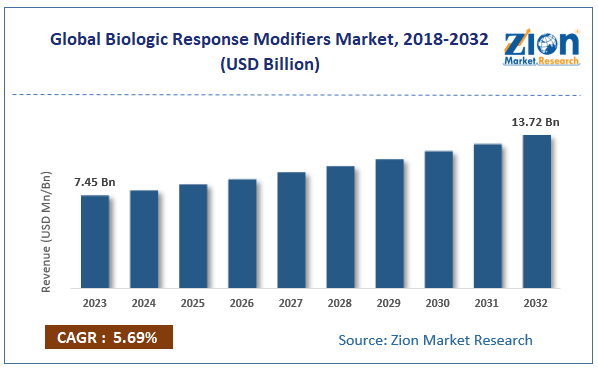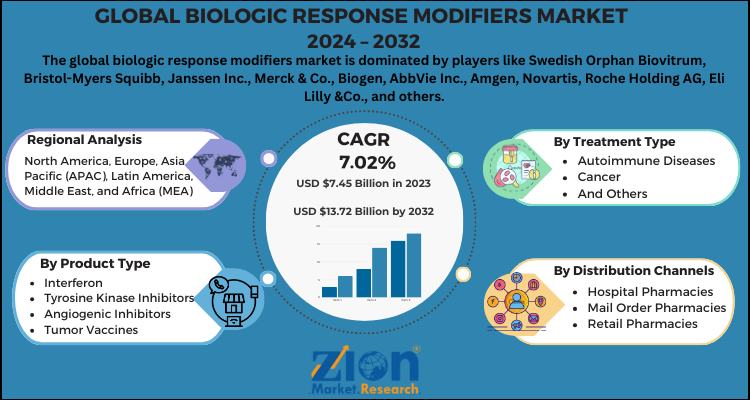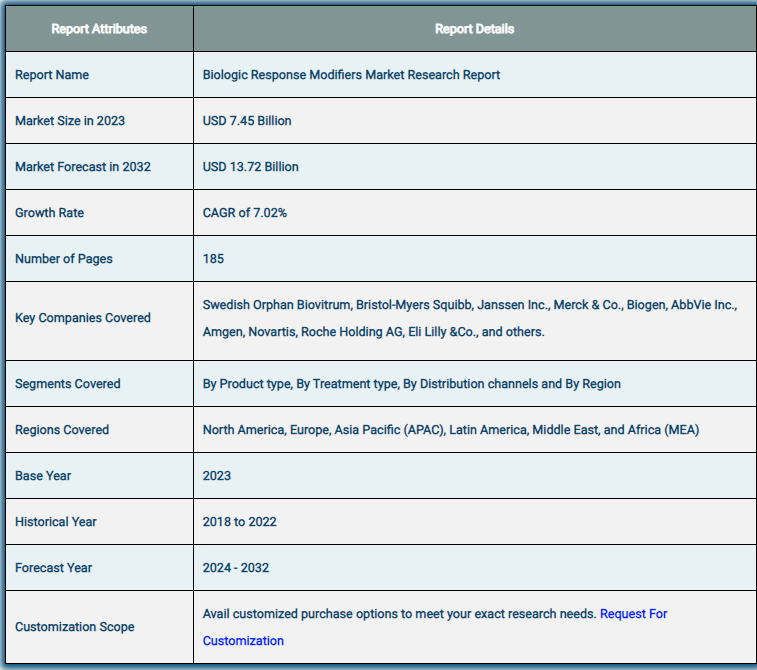Biologic Response Modifiers Market Size, Share and Forecast, (2024–2032)

The global biologic response modifiers market was estimated to be worth USD 7.45 billion in 2023 and is expected to grow to USD 13.72 billion by the end of 2032, according to a report released by Zion Market Research. Over the course of the projection period, the market is anticipated to rise at a CAGR of 7.02%. The study examines the factors that will propel growth, impede it, and affect demand for biologic response modifiers globally throughout the course of the projection period. Additionally, it will support you as you navigate and investigate the new potential in the industry of biologic response modifiers.
✈👉Get a Free Sample: 🚀https://www.zionmarketresearch.com/sample/biologic-response-modifiers-market
Introduction
The biologic response modifiers market is a dynamic segment of the biopharmaceutical industry that focuses on therapies aimed at modulating the immune system to improve disease outcomes. These biologics, including monoclonal antibodies, cytokines, and other therapeutic agents, play a crucial role in treating various diseases, particularly cancer and autoimmune disorders. This article provides an overview of the current state of the biologic response modifiers market, highlighting key drivers, challenges, market segmentation, and emerging trends.

Overview of the Global Market for Biologic Response Modifiers
Biologic response modifiers are chemicals that reduce or increase the immunogenic effect in order to help modulate the immune response. They are employed in immunotherapy and biological treatment to boost immune system function and combat illness or infection. These days, the pharmaceutical industry produces interleukins, interferon, colony stimulating factors, and monoclonal antibodies. Researchers are now more knowledgeable about identifying biological agents and effective targets thanks to several study projects.
Biologic response modifiers are agents that enhance or inhibit specific immune responses to help the body combat diseases more effectively. They include a variety of products such as monoclonal antibodies, recombinant proteins, and vaccines. The growing understanding of the immune system and advancements in biotechnology have led to the development of innovative biologics that are changing the landscape of disease treatment.
The global biologic response modifiers market has experienced significant growth due to increasing incidences of chronic diseases, advancements in research and technology, and the rising demand for targeted therapies. With the ongoing emphasis on personalized medicine, biologic response modifiers are becoming essential in the therapeutic arsenal against various diseases.
Market segmentation for biologic response modifiers worldwide
Biologic response modifiers are classified by product type, therapy type, and distribution channels in the global market. The market is divided into segments based on the kind of product, including interferon, monoclonal antibodies, tumor vaccines, tyrosine kinase inhibitors, angiogenic inhibitors, interleukins, colony stimulating factors, and TNF-α. The market is divided into categories such as cancer, autoimmune illnesses, and others based on the type of treatment. The market is split into hospital pharmacies, mail order pharmacies, and retail pharmacies based on the distribution channel.

Growth Factors for the Worldwide Biologic Response Modifiers Market
The market for biologic response modifiers is primarily being driven by the rise in autoimmune disease and cancer cases that are occurring globally. Immunotherapy is a successful treatment for people with various cancer types who are not responding to chemotherapy or radiation therapy. The fact that patients receiving biologic response modifiers may experience adverse effects including opportunistic infections and an increased chance of developing some serious disorders like viral infections or tuberculosis is one of the issues limiting the market’s growth. The market’s expansion will be constrained by certain manufacturing and export-related regulations. The high expense of biologics prevents them from being accessible to all individuals.
✈👉Directly Purchase a copy of the report with TOC: 🚀https://www.zionmarketresearch.com/toc/biologic-response-modifiers-market
Market Analysis of Biologic Response Modifiers: Report Extent

Regional Analysis of the Global Market for Biologic Response Modifiers
The market for biologic response modifiers is divided geographically into several regions, including Asia-Pacific, Latin America, Eastern and Western Europe, North America, and the Middle East and Africa. North America leads the market for biologic response modifiers, with Western Europe and the Asia-Pacific area following closely after. A large number of producers of biological medications and vaccines, accessible treatment options, high per capita income, and favorable reimbursements for life-threatening illnesses are the factors driving market growth in North America and Europe. In terms of both supply and demand, Western Europe comes in second. The Asia-Pacific market will expand at a healthy clip as a result of new pharmaceutical companies being established, rising cancer incidence, improved healthcare facilities, and expanding insurance coverage.
Key Market Segments
The biologic response modifiers market can be segmented based on product type, application, distribution channel, and region.
- By Product Type:
- By Application:
- By Distribution Channel:
- By Region:
Market Drivers
Several factors are propelling the growth of the biologic response modifiers market:
- Increasing Incidence of Chronic Diseases: The rising prevalence of cancer, autoimmune disorders, and infectious diseases drives the demand for effective biologic therapies. The global aging population further contributes to this increase.
- Advancements in Biotechnology: Continuous research and advancements in biotechnology are leading to the development of new biologic response modifiers. The ability to create targeted therapies has transformed treatment paradigms in various diseases.
- Rising Demand for Personalized Medicine: The shift towards personalized medicine is a significant driver, as biologic therapies can be tailored to individual patient needs, enhancing treatment efficacy and minimizing side effects.
- Growing Investment in R&D: Pharmaceutical companies are increasingly investing in research and development to innovate and expand their biologic product offerings. This investment fosters a competitive market with numerous treatment options.
Challenges in the Market
Despite its growth potential, the biologic response modifiers market faces several challenges:
- High Cost of Biologics: The development and production of biologics can be expensive, leading to high prices for patients. This may limit access to these therapies, particularly in developing regions.
- Regulatory Hurdles: The regulatory landscape for biologics is complex and stringent. Navigating the approval process can be time-consuming and costly for manufacturers.
- Risk of Adverse Effects: While biologics can be highly effective, they may also cause adverse effects in some patients. The potential for immune-related side effects requires careful monitoring and management.
- Competition from Biosimilars: As patents for many blockbuster biologics expire, biosimilars — similar versions of biologics — are entering the market, creating price competition and potentially impacting revenue for original biologic products.
Emerging Trends
Several key trends are shaping the future of the biologic response modifiers market:
- Increased Focus on Immunotherapy: Immunotherapy, particularly in oncology, is gaining traction. Innovative biologic response modifiers that enhance the immune system’s ability to fight cancer are at the forefront of research and development.
- Collaboration and Partnerships: Pharmaceutical companies are increasingly collaborating with research institutions, biotech firms, and academia to accelerate the development of new biologics and bring innovative therapies to market.
- Growth of Personalized and Precision Medicine: The emphasis on personalized medicine is driving the development of biologic therapies that are tailored to the genetic and molecular profiles of patients, ensuring more effective treatment outcomes.
- Integration of Digital Health Technologies: The adoption of digital health technologies, including telemedicine and remote patient monitoring, is enhancing patient access to biologic therapies and improving adherence to treatment regimens.
- Sustainability Initiatives: As environmental concerns rise, there is an increasing focus on sustainable practices in the production and distribution of biologics, including reducing waste and optimizing resource use.
Competitive Landscape
The biologic response modifiers market is characterized by intense competition among several key players, including:
- AbbVie Inc.
- Amgen Inc.
- Roche Holding AG
- Merck & Co., Inc.
- Johnson & Johnson
- Novartis AG
- Pfizer Inc.
- Bristol-Myers Squibb Company
These companies are engaged in extensive research and development efforts to introduce new biologics and expand their product portfolios. Strategic partnerships, mergers, and acquisitions are common in this market as companies seek to enhance their capabilities and market reach.
Future Outlook
The future of the biologic response modifiers market appears promising, with continuous advancements in technology and increasing demand for targeted therapies. The market is expected to grow significantly as novel biologics enter the market, particularly in oncology and autoimmune diseases.
North America currently dominates the biologic response modifiers market, attributed to a robust healthcare infrastructure, high healthcare expenditure, and significant investments in R&D. However, the Asia-Pacific region is anticipated to witness rapid growth due to rising healthcare demands, improving healthcare infrastructure, and increasing investments in biopharmaceuticals.
Conclusion
The biologic response modifiers market is positioned for substantial growth, driven by advancements in biotechnology and the rising demand for effective therapies in treating chronic diseases. As the landscape of healthcare continues to evolve, biologic response modifiers will play a pivotal role in enhancing patient outcomes and transforming disease management.
For manufacturers and investors, focusing on innovation, addressing regulatory challenges, and expanding access to biologic therapies will be crucial for success in this dynamic market.
✈👉Enquiry for buying: 🚀https://www.zionmarketresearch.com/inquiry/biologic-response-modifiers-market
Browse other trend reports:
Active Nutraceuticals Ingredients Market
Smart Plantation Management Systems Market
Contact Us:
Zion Market Research212
USA/Canada Toll Free: 1 (855) 465–4651
Newark: 1 (302) 444–016611\
Web: https://www.zionmarketresearch.com/
Blog: https://zmrblog.com/

Comments
Post a Comment